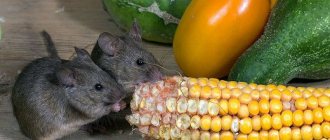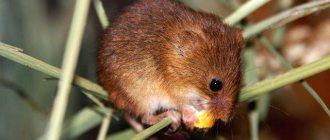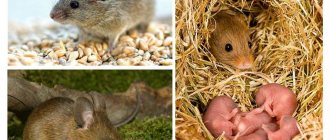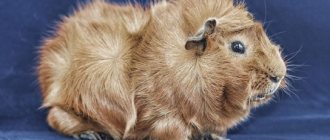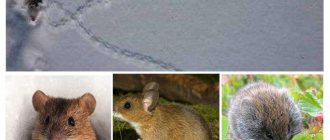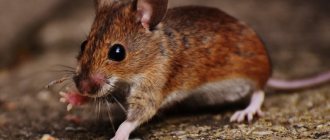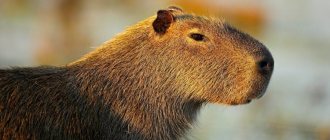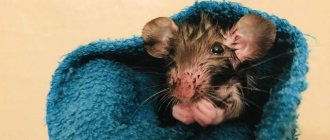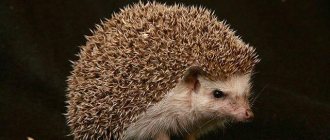Description
This small animal from the Mouse family (size from 7 to 17 cm) has other names - akomis, spiny Egyptian mouse. The weight of even adult individuals does not exceed 50 g. The unusualness of these animals lies in the hair, which on the back looks like real needles. The rest of the body is covered with soft sandy or brown hairs, only the belly and chest are lighter, sometimes completely white. Adult males have longer fur on their heads, which creates the appearance of a mane.
On the narrow muzzle there are black beady eyes and rather long vibrissae, with the help of which the animal easily navigates in space. Rounded, very mobile ears are set high. The short legs have a wide foot. The tail is almost the same length as the body and resembles a rat's. It is very fragile, often breaks, and in the wild it helps save the life of an animal that throws it off in a moment of danger.
The spiny mouse (photo can be viewed on the page) lives from 3 to 8 years, depending on the conditions of detention.
Kinds
Cairo mouse (Acomys cahirinus)
Body length from 7 to 14 cm, tail from 9 to 14 cm. Weight from 21 to 64 g. It has large eyes and ears, a pointed muzzle, a long scaly tail, and spiny hairs.
The belly and paws are white, there are stripes under the eyes. The color is reddish-brown. It lives in Africa, Libya, Egypt, Sadoun, Ethiopia and Djibouti.
Asia Minor spiny mouse (Acomys cilicicus)
This species is in danger of extinction. It is endemic to Turkey. The body has a length of 10 to 12 cm, weight 48 g.
The back is covered with hard, spiny hairs. A mouse with large eyes and ears, a bare short tail, colored gray.
Eastern spiny mouse (Acomys dimidiatus)
Lives in Jordan, Israel, Lebanon, Syria, Saudi Arabia, Oman, UAE, Iraq, Iran, Pakistan. Found on the Sinai Peninsula.
The animals have a body length from 95 to 124 mm, a tail from 93 to 122 mm, a weight of about 45 g. The belly is white and the coat is orange-brown. There are black individuals.
Cretan spiny mouse (Acomys minous)
Lives on the island of Crete. Lives in rocky mountain areas at an altitude of up to 1,000 m at sea level. It has large eyes and ears, a scaly tail, and needle-like fur.
The body length reaches from 90 to 130 mm, the tail - from 90 to 120 mm. Weight ranges from 30 to 86 g. White abdomen, the side of the body is colored red, and the upper part is gray.
Golden spiny mouse (Acomys russatus)
Lives in Egypt, Jordan, Israel, Saudi Arabia, Oman, and the Sinai Peninsula. It has a body length of 11 cm, a tail of 7.5 cm, and a weight of 37 to 75 g.
The fur coat is colored reddish-orange so that the animal can camouflage itself against the backdrop of sandy mountains. The belly and side of the body are painted white, the paws are gray. There are white stripes under the eyes.
Life in nature
These animals hide from their enemies mainly in shelters, but in the absence of such they flee. Despite its short legs, the mouse can run up to 15 km per day. If the situation is hopeless and there is no way to escape, the animal tries to scare away the enemy by spreading its needles, which makes it appear larger than it actually is.
Akomis live in groups, each of them is led by a female. There are practically no conflicts between members of the same community. Mice show amazing care for their relatives, raising their young together and caring for each other. Mothers are able to feed other people's babies who are left orphans. Such instincts help animals survive in the harsh conditions of semi-deserts. The spiny mouse does not like heat, so it leads an active life mainly at night.
Distribution and habitat of akomis
The habitat of the spiny akomis is extensive - these are the countries of the Middle East (mainly Saudi Arabia), the hot lands of Africa, the islands of Crete and Cyprus.
Favorite habitats are deserts, rocky areas of savannas and canyons. Akomis are social animals; they prefer to live in groups, helping and protecting each member of the settlement. Burrows, usually left behind by other rodents, are used as housing and shelter. But they are quite capable of digging their own housing.
They are active at night or early in the morning. In search of food, they often approach people’s homes and even settle in burrows under houses. One such settlement can cause significant harm to the crops that people grow.
Keeping at home
Constant communication with these amazing animals makes them quite tame. Recently, mice are often kept as pets. Considering that they live in families, it is always recommended to have several animals, with at least 2 females per male. Otherwise, the annoying boyfriend will not give rest to his only chosen one. You cannot keep several males together with females at the same time, because fights will arise between them, as a result of which the animals can injure or even kill the weaker one.
Otherwise, spiny mice feel great at home, and there are no particular difficulties with them. But to ensure the safety and comfortable living of your pet, you will need a specially equipped house.
Antiquity[edit]
Strabo calls mice born from the earth (gngeneis); according to his testimony, the Teucrians called them sons of the earth.
Among the Greeks, it is an attribute of Zeus (Jupiter), Sabazius and Apollo (it is assumed that the mouse served as food for his snakes).
According to Pliny, the Persian magicians considered mice to be the most religious animals. Ancient authors (Theophrastus, Aelian) noted the ability of mice to predict the weather, especially thunderstorms, by their behavior. The Greeks of Asia Minor had the belief that when marital fidelity is violated, mice cause terrible devastation in the house. In Greece, starting from the Homeric era, the cult of Apollo Smintheus (from sminyts “mouse”), whose attribute, symbol and sacred animal was the mouse, was widespread. Sometimes Apollo of Smyntheus was depicted standing on a mouse. Apollo was not only a destroyer of mice and a protector from them, but also their patron. Perhaps he himself was originally represented in the form of a mouse. Many mythological ideas about mice show similarities with ideas about muses in Greek mythology and characters genetically related to them. The parents of mice are the Thunderer (or sky) and mother earth (the wife of the Thunderer), the parents of the muses are Zeus the Thunderer or Uranus (sky) and Mnemosyne or Gaia (earth). The birthplace or habitat of mice and muses is a mountain (cf. the literal meaning of the proverb “The mountain gave birth to a mouse”). Mice are associated with fire, water, the world tree, muses - with a stone pillar. The leader of the mice is the mouse king or Apollo of Smyntheus, the leader of the muses is Apollo or Dionysus. Form of organization of mice and muses - round dance, attribute - arrow (through persecutors in mice, through Apollo in muses), functions (activities) - illness - health (causing damage - healing), blinding, singing, dancing, divination (fortune telling), memory - oblivion (whoever has tasted food touched by a mouse forgets the past; cf. the role of dead water, Lethe, opposing Mnemosyne, as well as the image of mice as the personification of death in different traditions), “fury”, trembling, chaotic revival (in mice before a thunderstorm , among the muses in connection with inspiration, creativity), etc. Ancient zoology mentioned their terrifying effect on elephants, their supposed conception through mutual licking and the view that mice in Egypt originated from the Nile mud and their liver increases and decreases depending on from lunar phases. The supposed voluptuousness of mice was the reason why they were depicted on coins along with the goddess of love Aphrodite (Venus).
Terracotta figurines of mice were found in excavations at the acropolis of Argos in Larissa (eastern Peloponnese). Apollo Sminteisky - protector from harm caused by mice
Home improvement
Akomis are kept both in glass aquariums, tightly closed on top with a metal mesh, and in cages. These animals are active and love to frolic, so their housing should be spacious. For five mice, its minimum size is 90 x 30 x 40 cm.
When choosing a metal cage as a home for rodents, it is necessary that the size of its cells be no more than 1 x 1 cm. An important condition for comfortable living of akomis is the surface area. To do this, all kinds of shelves, ladders, driftwood, etc. are placed in their home. To satisfy the need of these animals to move, it is necessary to install a wheel. It must be firmly attached and have solid solid walls to prevent injury to the fragile tail. Wheel diameter - at least 13 cm.
Several jars with two exits are also placed in the cage for arranging a nest and breeding offspring. One of the most important conditions is the absence of plastic items. Mice can easily chew them, swallowing pieces, which will lead to injury. To grind down the incisors, small wooden blocks or tree branches are placed.
Various materials are used as bedding - sawdust, sand, straw, dry leaves, moss. The spiny mouse is a very clean animal, setting up its toilet in one specific place. Therefore, you usually have to change the litter no more than three times a week.
A feeder and a water bowl must always be present in the cage. Thick ceramic dishes that animals cannot knock over are suitable for this purpose. Once a week, all items in the cage are washed with warm water and soap. Choose a place for mice to live away from heating devices and sunlight. Drafts should also be avoided. The most comfortable temperature for animals is 25–27 ⁰С, humidity is 30–35%.
Nutrition
Akomis adore plant foods, but sometimes they are not averse to eating protein-rich insects: grasshoppers, worms, cockroaches or bloodworms.
You can replace this food with any kind of nuts. Leave a few in the shell, this will help the mouse wear down its ever-growing incisors. You can also replenish protein with boiled eggs or cottage cheese.
The cereal mixture also fits perfectly into the diet. It can be diluted with dried fruits and dandelion greens. Mice love to chew on tree branches. It is easy to find balanced dry food for rodents on sale. It is rich in micro and macroelements important for the healthy development of the animal.
Do not feed Akomis fatty, smoked or salty foods. This also includes cheese. Make sure that the container with clean water is always full and that any remaining organic food does not rot in the aquarium.
Feeding
Spiny mice are omnivorous and completely unpretentious in food. Therefore, keeping them is not a hassle, although it is better to diversify the diet. It is based on grains - millet, oats, barley, wheat. Occasionally you can pamper your pet with seeds, nuts, berries, pieces of fruit or vegetables.
Akomis need animal protein, so once a week they are given mealworms or grasshoppers. A substitute for such a delicacy is cottage cheese, yogurt, boiled egg white, boiled chicken or liver. All this is required in small quantities. Everyone knows that representatives of this family love cheese, but it is not recommended to give it to small pets, because this product contains components harmful to them - salt and various preservatives. Any spicy or fatty foods are contraindicated for them.
The source of calcium, which the spiny mouse also needs, is crushed eggshells. In pet stores you can purchase special mineral stones intended for rodents, activated carbon and vitamin sticks. You just need to consult your veterinarian first.
Food should be in the feeder constantly, since metabolic processes in animals proceed quite quickly. It is only important to ensure that it does not lie too long and does not spoil. The water needs to be changed daily, and the feeder must be kept clean.
Natural enemies
The main natural enemies of this type of rodent are predatory mammals (steppe lynx caracal, desert fennec fox and others), reptiles and birds. In addition, Akomis have a competitive relationship with gerbils for food.
The needles made of bristles on the back, which are not only very stiff, but also divided into separate strands, help protect themselves from predators. Therefore, it is not easy for a predator who has caught this rodent to swallow it. Stubble is very irritating to the throat. This factor makes Akomis not a very desirable prey for enemies.
Reproduction
From the age of three months, akomis are already considered sexually mature. 42 days after mating, the female gives birth to cubs, whose weight is no more than 6 g. Usually there are from 1 to 3, but sometimes there are 5 babies in a litter. They differ from newborn decorative mice in that they are completely independent. Already from the first day, a small spiny mouse can do without its parents (photo below).
It looks somewhat different from its decorative tribesmen - the body is covered with hair, soft needles on the back, the head is large, and the legs are long. The main difference is that the eyes of newborn mice are open. Babies immediately try to start walking. They are able to independently maintain their body temperature, so they do not experience much need for maternal warmth. However, females feed on milk for another three weeks. She, in turn, takes care of the cubs and licks them thoroughly.
At one month of age, babies are separated from their mother into a general group of animals. Young animals are not kept completely separately, as this subsequently causes mental disorders and leads to the fact that mice lack the ability to communicate with their own kind.
A veterinarian is a specialist in rodent diseases.
However, if your little mouse still feels unwell, you need to contact a veterinarian, and the best option would be a special rodent doctor - a veterinarian-ratologist. Such a specialist knows well all the features of Akomis diseases, and will also help in matters of feeding and maintaining these charming pets.
Features of behavior
The spiny mouse is a nocturnal animal. She is most active in the dark. When purchasing such a pet, you need to be prepared for rustling, squeaking and other sounds to be heard at night. During the day, the animal may not even show itself, resting in its hole. The spiny mouse has the amazing ability to sleep with its eyes open.
Keeping these rodents at home requires accustoming them to handling, otherwise they may go wild. If you do not plan to breed mice, it is recommended to have two animals of the same sex, preferably males, since they are larger and much calmer than females. These pets love to sleep in a hammock. It can easily be made from a small piece of sheepskin.
You cannot pick up a spiny mouse by its tail - it is very brittle, and the animal can easily part with it. This also happens in case of danger. It is no coincidence that these animals with acquired short tails are often found in nature.
What kind of animal is that
Bats are a suborder of bats. The name is due to the anatomical structure: from the toes of the front paws through the sides to the hind limbs, an elastic membrane runs, connecting them (“hands” literally turn into wings). In nature, they prefer to settle in caves and rock crevices. In villages and cities they can be found in secluded dark places: in attics and abandoned buildings. They are characterized by a nocturnal lifestyle. Contrary to popular belief, they are not blind at all - they see (their vision is black and white), but they perfectly navigate in the dark thanks to their remarkably developed hearing.
On average, bats are small in size (comparable to small birds - tits, sparrows). At the same time, they are very nimble, and in flight they can reach speeds of up to 50 km/h. The body and head are covered with short fur that is soft to the touch, the muzzle, depending on the species, can be more or less similar to the muzzle of an ordinary mouse, but the ears of flyers are larger.
In the wild, these mice live for about 30 years. They will live a long time in captivity if the right conditions are provided.
Character
Spiny mice do best in a group. They are absolutely not aggressive, very sociable. They help each other in caring for their fur, and females raise their offspring together.
Akomis do not have good relationships with other domestic animals - they are always prey for cats, dogs and even birds. You shouldn’t risk letting the animals out for a walk; it’s better to provide them with a spacious and safe home. If there is a cat in the house, the tray needs to be properly protected, and a durable carabiner must be made on the cage.
For young children, close contact with mice can result in bites, and the pets themselves risk injury. Therefore, the cage must be placed in an inaccessible place and securely closed. Only children over 6 years of age who know how to handle animals can be trusted with pets such as spiny mice. At this age, the child is already quite capable of care, including feeding and cleaning the cage.
White mice
We should tell you more about this type of mouse. Such animals are kept by people as pets and as test subjects in laboratory research. Thanks to these little creatures with squirrel fur and red eyes, people were able to overcome many dangerous diseases and create many amazing medicines.
It is worth noting that white rodents have been known for a very long time. The first mentions of them in human chronicles date back to the 3rd millennium BC. However, this information does not stop “passionate” people who insist on every corner that white rodents are the result of secret experiments by scientists from closed laboratories.
In ancient times, white mice could be found in monasteries and countries. There these rodents were considered sacred. By the way, many eastern peoples named the first month of the year in honor of them.
In Japan they still believe that if there is a white mouse in the house, then other rodents will avoid it. And in China, such animals were used for predictions.
In Europe, white mice began to be bred en masse at the end of the century before last. They were bred for experiments. To this day, these rodents are the most valuable laboratory material for conducting various scientific experiments.
Diseases
In general, akomis (spiny mice) have fairly good health. How long animals live at home depends on the quality of care for them. The maximum age these pets can reach is 8 years. Unlike other rodents, they are less likely to suffer from problems such as various types of tumors. The most common non-communicable diseases are obesity, metabolic disorders, otitis media, and vitamin deficiency. Improper feeding can lead to diseases of the digestive system.
Hypothermia of a pet (for example, due to the cage being in a cold place or in a draft) can lead to the development of rhinitis, pneumonia, and bronchitis. Sometimes Akomis suffer from skin diseases caused by fungi or parasites.
Thanks to the unusual appearance of spiny mice, their amazing cleanliness and the lack of odor characteristic of many rodents, more and more people choose them as pets.
Health
Mice often develop tumors and, unfortunately, they are usually malignant. If you notice a lump, swelling, or other symptoms such as drowsiness and weight loss, these are signs of a tumor. Most tumors are removed by surgery, but they recur.
One of the most serious diseases for mice is “wet tail”. It is a gastrointestinal disease caused by bacteria in the digestive tract. If left untreated, the pet may die. The disease is manifested by diarrhea, drowsiness, lack of appetite and gait disturbance. This disease can be treated with antibiotics recommended by a veterinarian.
